This comprehensive guide tells you everything you need to know about bottom brackets — from a breakdown of all the bottom bracket systems available and their compatibility with one another to how a bottom bracket works and how to stop a bottom bracket creaking, this guide has it all.
It wasn't long ago that the only major bottom bracket decisions you had to make were shell width, spindle length, and, in rare cases, English (BSA) or Italian threading. These days, it can feel as though there are as many 'standards' as there are bike brands, with every one of them supposedly being the best option.
Below we rundown each of the major bottom bracket systems currently available, along with advantages, disadvantages, notes on compatibility, and some input from their proponents on why they exist.
- Conventional/BSA threaded
- BB90 and BB95
- PF86 and PF92
- BB30
- OSBB (road)
- BB30A and BB30-83 Ai
- PF30
- OSBB (mountain)
- PF30A and PF30-83 Ai
- BBRight
- BB386 EVO
- T47
- Threadfit 82.5
- SRAM DUB
Before we get stuck into the nitty-gritty of each standard though, we've put together this helpful crib sheet that runs through all of the key specifications.
Bottom bracket standards and compatibility
ISO threaded internal
Proprietary? No BB shell inner diameter 1.37in x 24 TPI Bearing inner diameter N/A, internal BBs have integrated spindle BB shell width 68mm road, 73mm mountain, 83mm downhill, 100/120mm fat bike Installation Threaded internal bearings Compatibility Square taper, Octalink, ISIS Other names BSA or BS threaded Other notes Bottom bracket must be specced with correct shell width and spindle length
ISO threaded external
Proprietary? No BB shell inner diameter 1.37in x 24 TPI Bearing inner diameter 24mm (Hollowtech II), 24/22mm (GXP), 25mm (Ultratorque/Powertorque) BB shell width 68mm road, 73mm mountain, 83mm downhill, 100/120mm fat bike Installation External cups Compatibility n/a Other names BSA or BS threaded Other notes External cups now exist that will take 30mm spindles
Italian threaded
Proprietary? No BB shell inner diameter 1.375in (34.92mm) x 24 TPI Bearing inner diameter 24mm (Hollowtech II), 24/22mm (GXP), 25mm (Ultratorque/Powertorque) BB shell width 70mm Installation External or internal Compatibility n/a Other names n/a Other notes Can be prone to undoing itself because non-driveside is a standard thread
BB90/BB95
Proprietary? Yes (Trek) BB shell inner diameter 37mm Bearing inner diameter 24mm BB shell width 90mm road, 95mm MTB Installation Pressed bearings with stepped BB shell Compatibility Designed specifically for 24mm spindles, no 30mm option Other names n/a Other notes The extra width of the BB cups is replaced with more frame real-estate
BB86/BB92
Proprietary? No BB shell inner diameter 41mm Bearing inner diameter 24mm BB shell width 86.5mm road, 91.5mm MTB. Other widths may be named according to shell dimensions: 89.5mm, 104.5mm, 107mm, 121mm, 132mm Installation Bearings pressed in cups Compatibility Originally designed for 24mm spindles, but some BBs that fit a 30mm spindle are available Other names PF41 (Hope – refers to BB shell diameter), PF24 (Chris King – refers to spindle diameter) Other notes Similar to above, but a non-proprietary version with less stringent tolerances
BB30
Proprietary? No (open Cannondale standard) BB shell inner diameter 42mm Bearing inner diameter 30mm BB shell width 68mm road, 73mm MTB Installation 6806 bearings pressed into frame with circlips to locate in BB shell Compatibility Designed for specific BB30 cranks, 24mm step-down spacers available Other names n/a Other notes Narrow overall width means longer spindles can be used with appropriate spacers
BB30A and BB30-83 Ai
Proprietary? Yes (Cannondale) BB shell inner diameter 42mm Bearing inner diameter 30mm BB shell width 73mm (BB30A), 83mm (BB30-83) Installation 6806 bearings pressed into frame with circlips to locate in BB shell Compatibility n/a Other names n/a Other notes Asymmetric BB shell which is wider on non-driveside. Wider overall shell is also claimed to improve bearing support
PF30
Proprietary? No (SRAM) BB shell inner diameter 46mm Bearing inner diameter 30mm BB shell width 68mm road, 73mm MTB Installation 6806 bearings in cups Compatibility Originally designed for BB30 cranks Other names n/a Other notes Analogous to BB30 above, but uses pressed cups (with identical bearings) for relaxed manufacturing tolerances
OSBB (Road)
Proprietary? Specialized BB shell inner diameter 42mm Bearing inner diameter 30mm BB shell width 68mm Installation Pressed 6806 bearings with circlips in BB shell Compatibility Designed for specific BB30 cranks Other names n/a Other notes OSBB for Specialized Road bikes appears to just be BB30. An older Pressfit 61x46mm BB appears to be obsolete
OSBB (Mountain)
Proprietary? Specialized BB shell inner diameter 46mm Bearing inner diameter 30mm BB shell width 73mm Installation 6806 bearings in cups Compatibility Originally designed for BB30 cranks Other names n/a Other notes OSBB for mountain bikes appears to be PF30 (post 2010). An older 84.5x46mm BB appears to be obsolete.
PF30A and PF30-83 Ai
Proprietary? Yes (Cannondale) BB shell inner diameter 46mm Bearing inner diameter 30mm BB shell width 73mm (BB30A), 83mm (BB30-83) Installation 6806 bearings in cups Compatibility n/a Other names n/a Other notes Essentially the Pressfit version of BB30A and BB30-83
BBRight (Direct Fit)
Proprietary? No (Cervélo) BB shell inner diameter 42mm Bearing inner diameter 30mm BB shell width 79mm (road only) Installation 6806 bearings pressed into frame with circlips to locate in BB shell Compatibility BBRight cranks and wider Other names n/a Other notes Similar asymmetric concept as Cannondale Ai, but the shell is wider
BBRight (Press Fit)
Proprietary? No (Cervélo) BB shell inner diameter 46mm Bearing inner diameter 30mm BB shell width 79mm (road only) Installation 6806 bearings in cups Compatibility BBRight cranks and wider Other names n/a Other notes Similar asymmetric concept as Cannondale Ai, but the shell is wider
BB386EVO
Proprietary? No (FSA) BB shell inner diameter 46mm Bearing inner diameter 30mm BB shell width 86.5mm road Installation 6806 bearings in cups Compatibility Will take 386EVO cranks and traditional external BB cranks Other names n/a Other notes Matches the wide bearing spacing of a BSA external BB with a large 30mm spindle
BB392EVO
Proprietary? No (FSA) BB shell inner diameter 46mm Bearing inner diameter 30mm BB shell width 91.5mm MTB Installation 6806 bearings in cups Compatibility Will take 386EVO cranks and traditional external BB cranks Other names n/a Other notes Matches the wide bearing spacing of a BSA external BB with a large 30mm spindle
T47
Proprietary? No (Chris King & Argonaut Cycles) BB shell inner diameter M47 x 1 Bearing inner diameter 30mm BB shell width 68mm road, 73mm MTB Installation Threaded cups with bearings Compatibility Cross compatible dependent on spindle length Other names Thread Fit 30i Other notes Aims to solve creaking issues of press fit systems. Essentially an oversized BSA external BB
Thread Fit 82.5
Proprietary? Yes (Colnago) BB shell inner diameter 41mm (when shell is fitted) Bearing inner diameter 24mm (30mm) BB shell width 86.5mm road Installation Threaded BB shell takes aluminium shell, which is then fitted with BB86 bearing cups Compatibility Originally designed for BB86 cranksets and bearings. New integrated CeramicSpeed BB fits 30mm spindle cranks Other names n/a Other notes Threaded shell can be made with better tolerances and can be replaced if it wears out. CeramicSpeed now offers a fully integrated bearing (akin to T47) that will fit 30mm spindles
We've also included a section on how you can (or can't as the case may be) change between different bottom bracket standards and an explainer on why there are so many standards in the first place.
Conventional/ISO/BSA threaded bottom brackets
Modern, external cup threaded bottom brackets are among the most common of standards. Square taper bottom brackets also fit in most shells designed for external cup bottom brackets, but to keep things simple, we will only cover the modern standard here.
The idea is simple, by moving the bearings outboard of the shell, you can then use a much larger spindle. Currently, 24mm is the accepted norm compared to square-taper's relatively minuscule 17mm diameter.
External bottom brackets for 30mm spindles do exist, such as those from White Industries, allowing modern 30mm-diameter axle cranks to be used.
Shimano popularised the concept as Hollowtech II, with the introduction of the XTR M960 group in 2003 — even now it's still arguably the gold standard for bottom brackets. In fact, companies such as Santa Cruz continue to stand by it despite the plethora of other options now available.
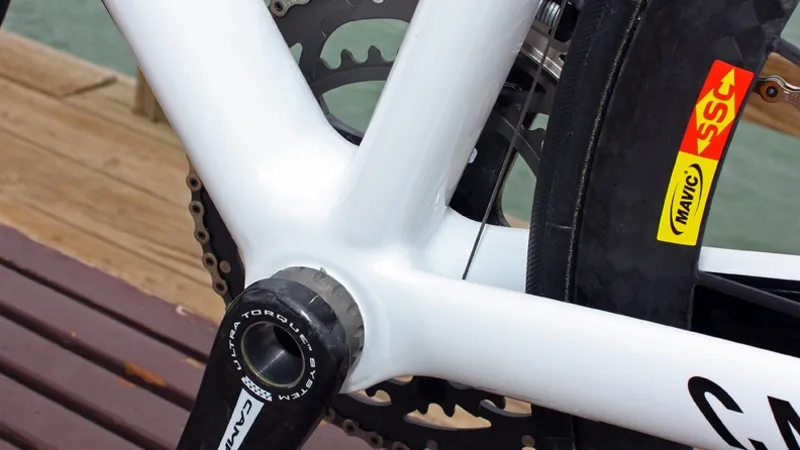
"Threaded bottom brackets are compatible with the largest range of cranks [and] some press-in bottom brackets have a reputation for creaking," Santa Cruz global marketing manager, Will Ockelton, tells BikeRadar.
"Press-in bottom brackets require special tools, which most consumers don't have [and] they can only be installed a few times before it's recommended that you replace the bearings [or cups — ed.]. Most of our bikes come with ISCG tabs, but for the few that don't, a thread-in bottom bracket still allows for chain guide mounting.
"A threaded bottom bracket is great because it isolates the bearing from the frameset," adds Matt Harvey, president of bearing, seal and bottom bracket maker Enduro.
"Because you have aluminium threads and surfaces, you can face the shell with a cutter and make it parallel if it is not. The bearing bores are usually round already, with aluminium cups, because it is a machined surface, and if the bearing bores are too tight you can sand them out and get the fit just right for the bearings before you thread them into the frame. You cannot use a facing or cutting tool that I know of in a carbon shell."
- Pros: Easy at-home service; interface surfaces can often be machined; huge selection of parts and accessories
- Cons: Heavier than press-fit systems; frame design limited by relatively small-diameter and narrow shell
- Crank designs that will fit: Standard 24mm external type (Shimano Hollowtech II, SRAM GXP, Campagnolo Ultratorque and Powertorque, FSA MegaExo, Race Face X-Type, etc), square taper, ISIS, BB386EVO, BB392EVO many others. Crucially external cups that fit 30mm spindles do exist.
A note on other threaded bottom bracket standards
To make matters even more confusing, there exists a number of other threaded bottom bracket standards.
Excluding the relatively new T47 standard (more on that later), the one you're most likely to come across is the Italian threaded bottom bracket.
To keep matters simple, we've put together a simple explainer on this slightly esoteric of standards here.
BB90 and BB95 bottom brackets
Trek introduced the proprietary BB90 standard in 2007 on the revamped Madone and soon followed with the mountain bike-specific BB95.
Instead of bearing pressed into aluminium cups that were then threaded into the frame, Trek pressed the bearings directly into the frame.
Bearing seats were moulded into the carbon frame structure to save weight, and bottom bracket shell width ballooned to 90mm on road bikes and 95mm on mountain bikes, creating more real estate for frame tubes and suspension pivots.
Effectively, the space previously taken up by the bearing cups can now be used as frame real-estate, allowing larger (and stiffer) tubes to be used.
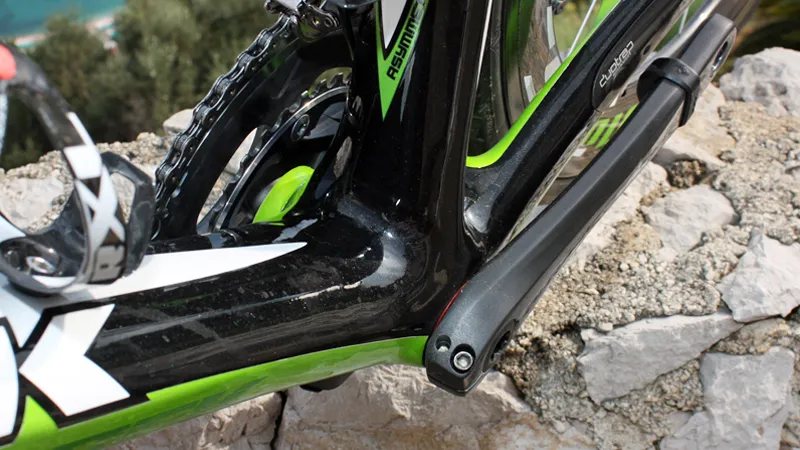
"The most significant [advantage] is a stiffer frame," says Trek mountain bike product manager John Riley. "Secondarily, BB90/95 offers a lighter overall solution by replacing traditional alloy bearing cups with integrated carbon bearing bores. It also provides a simplified installation process."
Aside from omitting the cups, the BB90/95 setup is functionally identical to conventional threaded bottom brackets, in that it uses the same bearings and the same bearing locations as before. Crankset compatibility is thus unchanged, although you do lose the ability to run chain guides that sandwich between the driveside cup and frame.
This system is not without its issues however, with shells becoming oversized (due to wear) being a relatively common problem (leading Trek to release the very slightly oversized V2 bearings to compensate).
Perhaps partly due to these issues, Trek has, in fact, recently abandoned this bottom bracket standard on its Domane endurance road bike platform for 2020, in favour of the T47 threaded standard. It will be interesting to see if this trend carries over to future models in its range.
- Pros: Lighter than conventional setups but retains compatibility with 'legacy' cranksets; creates a wider BB shell without affecting crank width
- Cons: Can't use cup-mounted chain guides; shell is wider but still small in diameter; requires a separate bearing puller and press for service, bearing bores can wear out and loose tolerances
- Crank designs that will fit: Standard 24mm external-type only. A GXP conversion kit is also available
BB86 and BB92 bottom brackets
Very closely related to Trek's BB90/BB95 system is the BB86/BB92 standard used by Scott, Giant, Pivot, and many others.
Once again, the bearings and their locations are identical to those of conventional threaded bottom brackets, only they're mounted in small composite cups before being pressed into the frame.
The advantages are similar to those for Trek's BB90/95; a wider bottom bracket shell that doesn't otherwise affect crank width, plus lighter weight compared with threaded alloy cups.
From a manufacturing standpoint, BB86/92's dimensional tolerances aren't as stringent as BB90/95's, and it's easier to adapt the system into alloy frames. So long as you have a concentric bore of the right diameter, parallel faces, and a proper shell width, you're good to go.
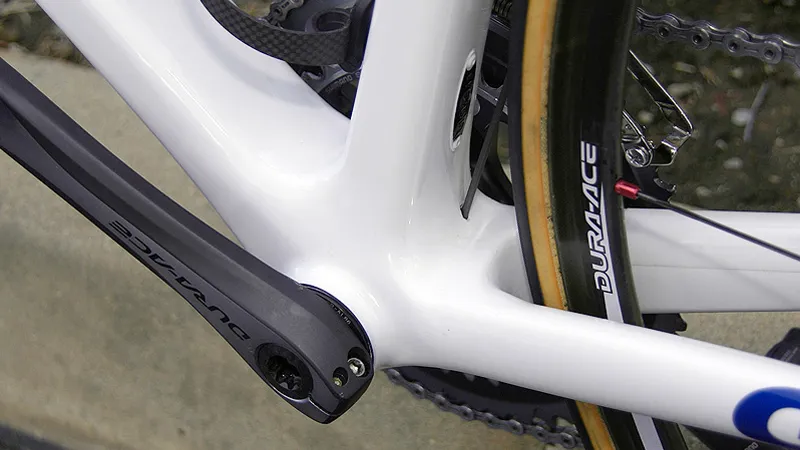
"Because of this technology, we're able to improve pedalling stiffness [by about] 10% on some of our frames, over traditional threaded bottom brackets," says Giant global marketing director Andrew Juskaitis. "[PF86/92 is] less subject to tolerances, too, and is able to take up +/- 0.5mm of [shell width] discrepancy."
Scott US marketing and PR director Adrian Montgomery touts similar reasons for his company choosing BB86/92 over other standards:
"We can create frames with a wider bottom bracket shell, thus adding stiffness to the entire structure as the adjoining tubes can also be wider. We can do this without creating our own crank spindle standard because it adheres to the same spindle that a threaded BB uses. It's also lighter than a threaded BB because we've removed the alloy material that held the bearings outside the shell [and] it costs less to do a press-fit bottom bracket in regards to manufacturing. Disadvantages? None that I can see."
The road standard has an 86.5mm shell width (hence BB86) whilst the mountain bike standard has a 91.5mm shell width. A number of other shell widths may also exist, though they all use the same bearing cups.
More recently, bearings have shown up that allow a 30mm spindle to be used. The dimensional restriction mean the bearings are generally quite small, as the system was designed around 24mm spindles. This can lead to reduced bearing lifetimes.
This system has a number of different names depending on who you talk to. It is also called PF86, PF92, PF24 (Chris King) and PF41 (Hope).
- Pros: Same as BB90/95
- Cons: Same as BB90/95 in theory, but in practice there are generally less issues experienced due to the less stringent tolerances
- Crank designs that will fit: Standard 24mm external-type, 30mm spindle bottom brackets are available for e.g. BB386 EVO, BB392EVO
BB30 and OSBB bottom brackets
Several companies have dabbled in alternative bottom bracket standards over the years (Gary Fisher, Klein, and Merlin, to name just three) but it wasn't until Cannondale released its then-proprietary BB30 system as an open standard in 2006 that something actually stuck.
BB30's bearing cartridges press directly into a precision-fit shell, as with Trek's BB90/95 system — albeit with the additional aid of two pairs of snap-rings/C-Clips.
But here it's the shell and spindle diameters that increase in size, not the shell width.
The key benefits are lighter weights owing to the larger, 30mm-diameter aluminium spindle and the elimination of separate bearing cups. Plus, because the shell is still just 68mm wide, the cranks can also be made to provide more heel clearance — or, depending on the crank design, an even a narrower stance width (commonly referred to as Q factor).
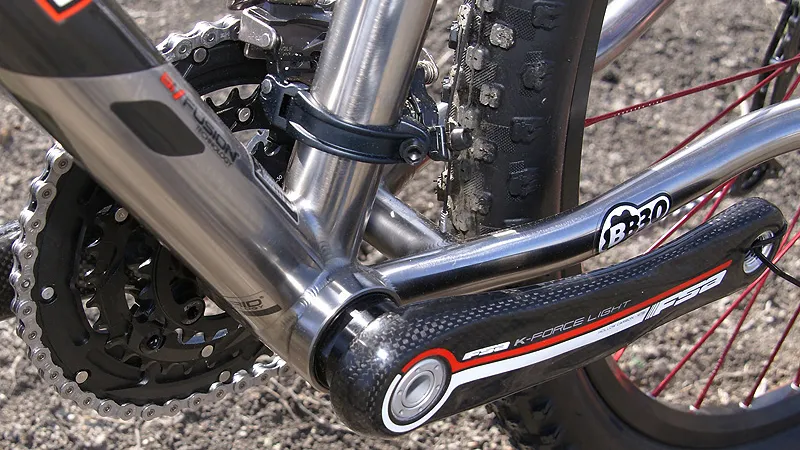
"The idea was that, since Cannondale had control of both the frame and crank manufacturing, we could use system integration to design a superior solution, even if that meant not relying on a traditional industry standard," says Cannondale vice president of R&D, Chris Peck. "[Advantages are] a lighter and stiffer crank with the 30mm alloy spindle; more room in the bottom bracket area to attach larger down tubes, seat tubes, and chainstays; and very low bottom bracket weight."
"[Our] Hollowgram SiSL2 crank with SpideRing weighs 484g. By comparison, Dura-Ace 9000 weighs around 678g [we recorded 637g in our review – ed]. In addition to weight, another BB30 advantage is stiffness. By increasing the spindle diameter, you increase its resistance to twisting, which is where the bulk of the deflection in a crankset comes from. Roughly 70% of total deflection measured at the pedal comes from axle twist."
BB30 shells, however, do require more stringent dimensional tolerances to work well, meaning that they're more expensive to manufacture. Moreover, with the notable exception of Felt, which uses a carbon tube, BB30 also usually employs an alloy shell insert that has to be bonded or co-moulded into an otherwise carbon frame.
Specialized's uses this standard for some of its high-end road bikes, but calls it OSBB.
- Pros: Lighter weight; more resistant to axle twist; more heel clearance; larger-diameter shell and spindle; potential for narrower pedal stance width
- Cons: Shell still just 68mm wide; metal-on-metal interfaces can be prone to creaking; requires a separate bearing puller and press for service; requires high manufacturing tolerances; bearing seats can't easily be faced post-manufacturing
- Crank designs that will fit: BB30, BB386 EVO, standard 24mm external-type, Specialized OSBB, BBRight. Can be adapted to almost any standard with suitable adapters.
BB30A and BB30-83 Ai bottom brackets
More recently, Cannondale announced a variant of BB30 called BB30A. This uses a shell that's 5mm wider than the original but it's an asymmetrical layout that only adds those extra millimetres on the non-driveside. According to Cannondale, this allows for wider bearing spacing and better spindle support (which should improve bearing longevity).
Other critical dimensions, such as bearing outer diameter and thickness, remain unchanged and there's also no difference in pedal stance width or ankle clearance (in most cases).
That extra 5mm can complicate crank compatibility, however. BB30-compatible cranks that feature axle spacers on the non-driveside (such as from Cannondale and SRAM) will work just fine because all you'll have to do is remove spacers as needed to accommodate the extra width, but BB30 cranks without such spacers (such as from FSA and Specialized) won't work.
Thankfully, many newer BB30-compatible cranks now feature extra-long spindles for wider compatibility and those will install just fine.
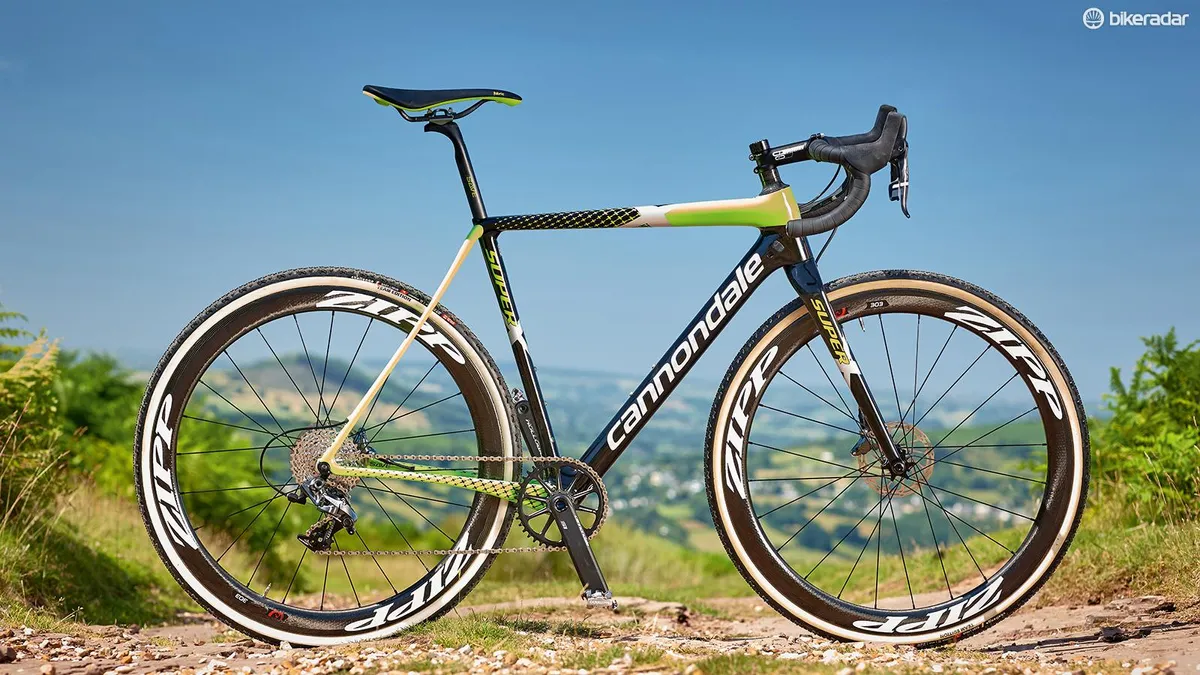
Cannondale also introduced another bottom bracket standard in the form of BB30-83 Ai.
First used on the brand's SuperX 'cross bike, the standard works in exactly the same way as BB30A, but sees the shell ballooned out to 83mm wide, improving tyre clearance and, supposedly, stiffness.
- Pros: Lighter weight; more resistant to axle twist; more heel clearance; larger-diameter shell and spindle; potential for narrower pedal stance width
- Cons: Metal-on-metal interfaces can be prone to creaking; requires a separate bearing puller and press for service; requires high manufacturing tolerances; bearing seats can't easily be faced post-manufacturing; not all BB30 cranks will fit
- Crank designs that will fit: BB30 (some), BB386 EVO, standard 24mm external-type, BBRight
PF30 and OSBB bottom brackets
SRAM addressed BB30's stringent dimensional tolerances and associated manufacturing costs with the advent of PressFit 30 in 2009. Just as with PF86/92, PF30 is analogous to BB30 in that the bearings and bearing locations are identical, but with the addition of intermediary composite cups that allow for looser frame tolerances.
Not surprisingly, then, PF30 has gained widespread traction in the industry, particularly with smaller manufacturers who can't afford high reject rates.
Specialized uses PF30 for its high-end mountain bike, confusingly also calling it OSBB though it is a different standard to the OSBB standard found on its road bike.
"I think it's more about the simplicity of the manufacturing process," says Drew Guldalian of Pennsylvania-based custom builder Engin Cycles. "Boring out a [standard] BB30 is not impossible, but in my opinion it's an unrealistic task from a manufacturer's standpoint that needs to do something to make money.
"With the PressFit 30, they're using the same technology with the larger bearings and the same technology with the bearings living inside the frame, but they're utilizing the nylon to their advantage where you have a more realistic tolerance."
"PressFit 30 fundamentally provides all the most significant advantages of BB30 but requires much less precise machining of the bottom bracket shell area, as the bearings come inserted into plastic cups that are easier to fit into the frame and less delicate than standalone bearing," adds SRAM drivetrain product manager Chris Hilton. "PF30 bottom brackets also have an integrated sealing system, which helps prolong bearing life."
Cannondale's Chris Peck provided BikeRadar with specific details. While BB30's bearing bore tolerances are 41.96 +0.025/-0mm (meaning the bore can be slightly oversized but not undersized), PF30's requirements are 46.00 +0/-0.05mm – exactly half as rigorous.
Specialized's OSBB system is nearly identical to BB/PF30 but with a few key differences, according to the company's director of advanced research, Chris D'Aluisio.
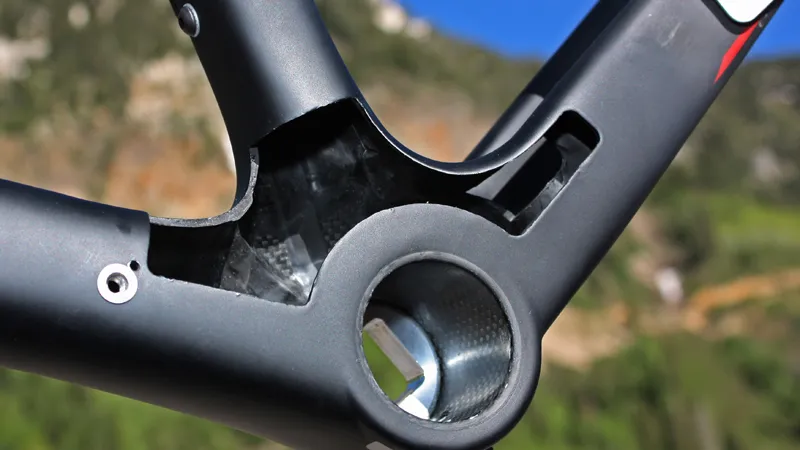
"The 30mm bearing is a good choice when using thinwall aluminium spindles," he says, "and the narrow bearing stance (relative to outboard bearings) works perfectly with our carbon arm design needing to make the turn into the spindle. The OSBB is basically the same as BB30 but with a little tighter tolerances and a 0.5mm difference in the clip-to-clip dimension. Cranks of both systems are compatible with each other."
D'Aluisio even argues that OSBB offers alignment advantages compared with threaded shells:
"The tolerances are not too different but the way they're measured is. They both have the same needs for concentricity and placement relative to the frame. The threads are at a disadvantage in that they need to be machined from both sides and have a hard time sharing a centerline, whereas our OSBB is machined from one side all at once — and round holes are easy to measure."
- Pros: Same as BB30 but with lower costs, easier assembly, and the potential for additional bearing seals integrated into the cup/bearing assembly
- Cons: Standard-width shell; requires a separate cup remover and press for service
- Crank designs that will fit: BB30, BB386 EVO, standard 24mm external-type, Specialized OSBB, BBRight
PF30A and PF30-83 Ai bottom brackets
This is essentially the same as the BB30A and BB30-83 Ai Cannondale system described above, except that it uses bearing cups rather than bearings pressed directly into the frame.
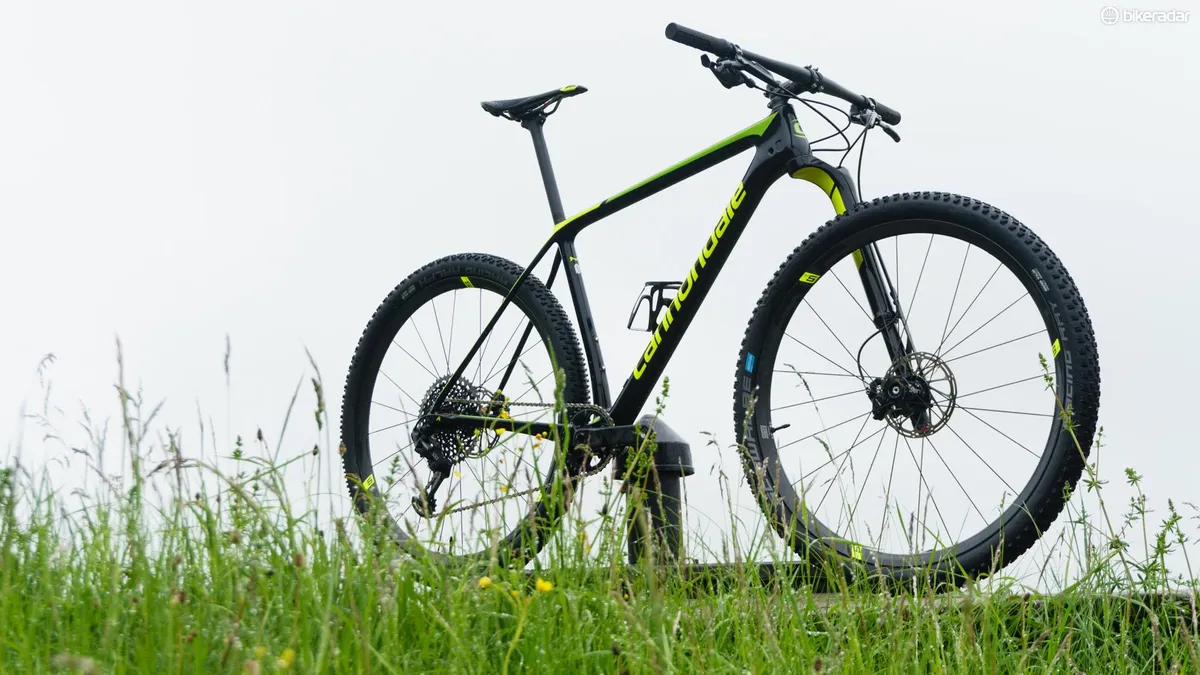
Similarly, it's largely based on the PF30 design, though with a 5mm wider, asymmetric bottom bracket shell — 73mm for PF30A and 83mm for PF30-83.
- Pros: As for BB30A and BB30-83 Ai
- Cons: Similar to BB30A and BB30-83 Ai, though press-fit design relaxes tolerance requirements
- Crank designs that will fit: BB30 (some), BB386 EVO, standard 24mm external-type, BBRight
BBRight bottom brackets
Most bottom bracket fitments incorporate bearings that are symmetrically positioned about the frame's centerline. Much like the Cannondale design, Cervélo tipped that apple cart in 2010, however, with the introduction of BBRight.
BBRight shares its 30mm-diameter alloy spindle, cartridge bearings, and driveside bearing location with PF30 — in fact, the bottom bracket cups are identical to PF30.
However, the non-driveside bearing is pushed outward by 11mm — the same as conventional threaded, BB90, and PF86 bottom brackets. This makes it something of a hybrid between the two widely accepted systems.
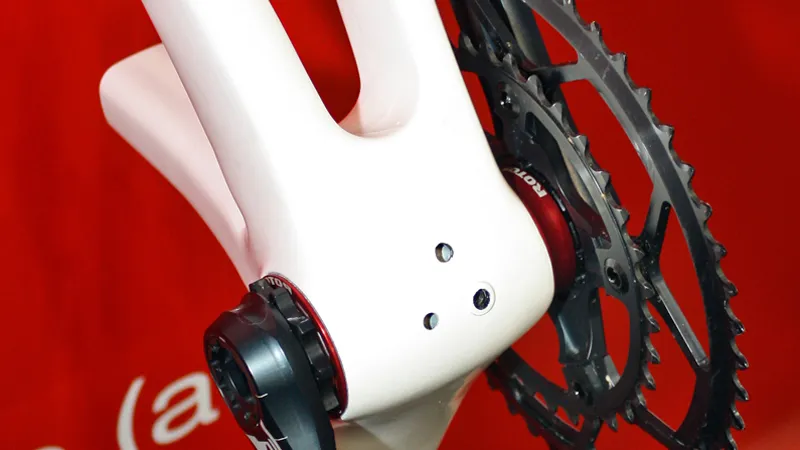
"BBRight uses the 11mm space occupied by an external bottom bracket’s left bearing cup to let the designer widen the frame tubes that connect to the bottom bracket shell: down tube, left chainstay and seat tube," says Cervélo race engineer Damon Rinard. "All these can be 11mm wider now. In the case of the chainstay, that’s nearly double the width at an important and highly loaded point — the junction with the bottom bracket — which has a several-fold beneficial effect on stiffness."
"The resulting increase in moment of inertia has gained us so much stiffness and strength that the left chainstay weighs less than the right, despite being stiffer and stronger," he continues. "Because stiffening either chainstay stiffens the frame, the net result is a substantial increase in the frame’s bottom bracket stiffness, together with a small reduction in frame weight."
Rinard insists this revised bearing spacing comes with no functional downsides, either:
"This performance boost comes with no other changes to basic dimensions: the left bearing stays in the same spot; the aluminium cup is simply replaced with carbon frame now. And since the bearing’s in the same spot, the lateral position of the left crank isn’t changed at all, so Q-factor is also unchanged. Your feet are in exactly the same place as before."
BBRight is available in two incarnations. The direct fit version uses the same 6806 bearings from a BB30 bottom bracket, which are pressed directly into the frame.
The press fit version uses removable bottom bracket cups, similar PF30 and is used on all other Cervélo frames and has also been adopted by some 3T designs.
From the outset, Cervélo introduced BBRight as an open standard that anyone could jump onto. While it seems to make good engineering sense, however, other bike companies have been slow to come on board.
- Pros: Stiffer than BB/PF30, in theory, without impacting other attributes; good crank compatibility, cheaper to manufacture than threaded or BB30
- Cons: Questionable longevity; requires a separate cup remover and press for service
- Crank designs that will fit: BBRight, BB386 EVO, standard 24mm external-type
BB386 EVO & BB 392 EVO bottom brackets
BB386 EVO and BB392 EVO, introduced in 2011, take the oversized principle to extremes. The bearings have the same 86/92mm spacing, width-wise, as conventional threaded external BB, BB90/95, and PF86/92 formats, but it uses BB/PF30's bigger 30mm diameter spindle.
As stiffness is directly tied to cross-sectional size it's no surprise that, theoretically, BB386 EVO has the most to offer, with both the added shell width and diameter that many frame-makers yearn for.
In addition, it uses the same bearings and cups as PF30 and BBRight and, thus, the same manufacturing tolerances and required tools.
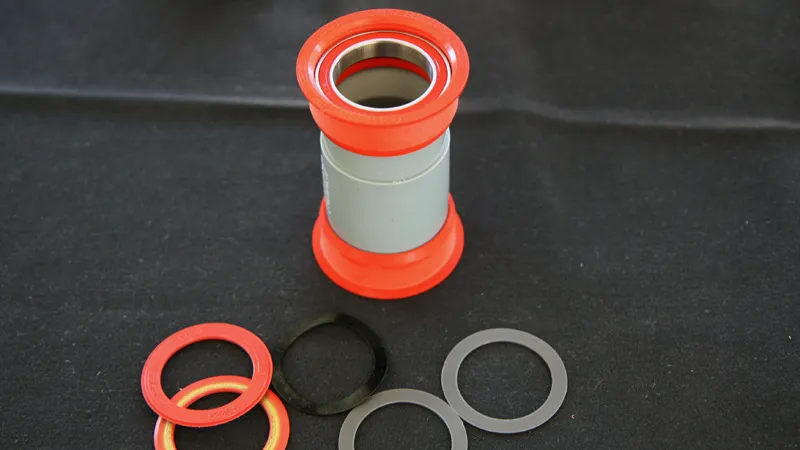
"[BB386 EVO] allows us to go wider, which in turn opens up big opportunities in terms of stiffness and strength in the bottom bracket/chainstay area," says BH president and CEO Chris Cocalis (Cocalis holds the same position with Pivot Cycles, whose frames are built around the more mountain bike-friendly PF92 format). "With bigger cross-sections driving stiffness, we also have more flexibility in being able to tune ride quality with the carbon layup."
"For us, there are no disadvantages versus a threaded design or a standard BB30. We are able to have a full carbon shell with no metal bonded into the frame, which makes for a stronger, lighter frame structure.
"With our manufacturing methods, we also have no issues holding tolerances. [BB386 EVO] wasn’t designed as a cost reduction, but not having to post bond an aluminium shell into the frame and make sure the facing and threads are correct is slightly less expensive and much more reliable."
Crank compatibility is another BB386 EVO strongpoint. Despite the bulbous dimensions, the shell will accept most modern crankset fitments save for dedicated BB30/PF30 and BBRight designs.
"The BB386 EVO cranks are compatible with almost every BB shell standard (BSA, BB30, PF30, BB86)," says Jason Miles of FSA. "We currently make bottom brackets and adaptors for BSA, BB30, and PF30 frames and are working on BB86 bottom brackets. Frames with BB386 EVO shells should be able to run almost any crank. We currently make adaptors to fit Shimano, Campagnolo, and SRAM 24mm spindle cranks."
While the surrounding frames should be stiffer than those built around narrower BB/PF30 or threaded shells, Miles admits that the BB386 EVO crankset actually takes a slight step back in that regard, but only when viewed independently of the entire system. The straighter arms also have less ankle and heel clearance than those narrower formats.
"Because the crank arms are straighter, we can make them lighter than BB30 ones," he says. "But because the BB386 EVO spindles are longer than BB30 ones, they aren't as stiff. Total stiffness is not a measure of crank stiffness alone, though. When you factor in the stiffness gains from a wider shell, the overall stiffness will be highest when BB386 EVO frames meet BB386 EVO cranks."
- Pros: Theoretically the best in terms of frame stiffness; reduced manufacturing costs; generous crankset versatility
- Cons: Heel clearance isn't as good as BB30; requires a separate cup remover and press for service
- Crank designs that will fit: BB386 EVO/BB392 EVO specific, standard 24mm external-type (can be adapted), BBRight, BB30 (axle width dependant),
T47 bottom brackets
Designed in conjunction with Chris King and Argonaut Cycles, T47 – announced in 2015 – is the most recent offering hoping to become the next standard. T47 bottom brackets, aka Thread Fit 30i, use the same 46mm internal diameter as PressFit 30, but they thread into frames rather than being pressed in.
This standard is also sometimes known as Threadfit 30i.
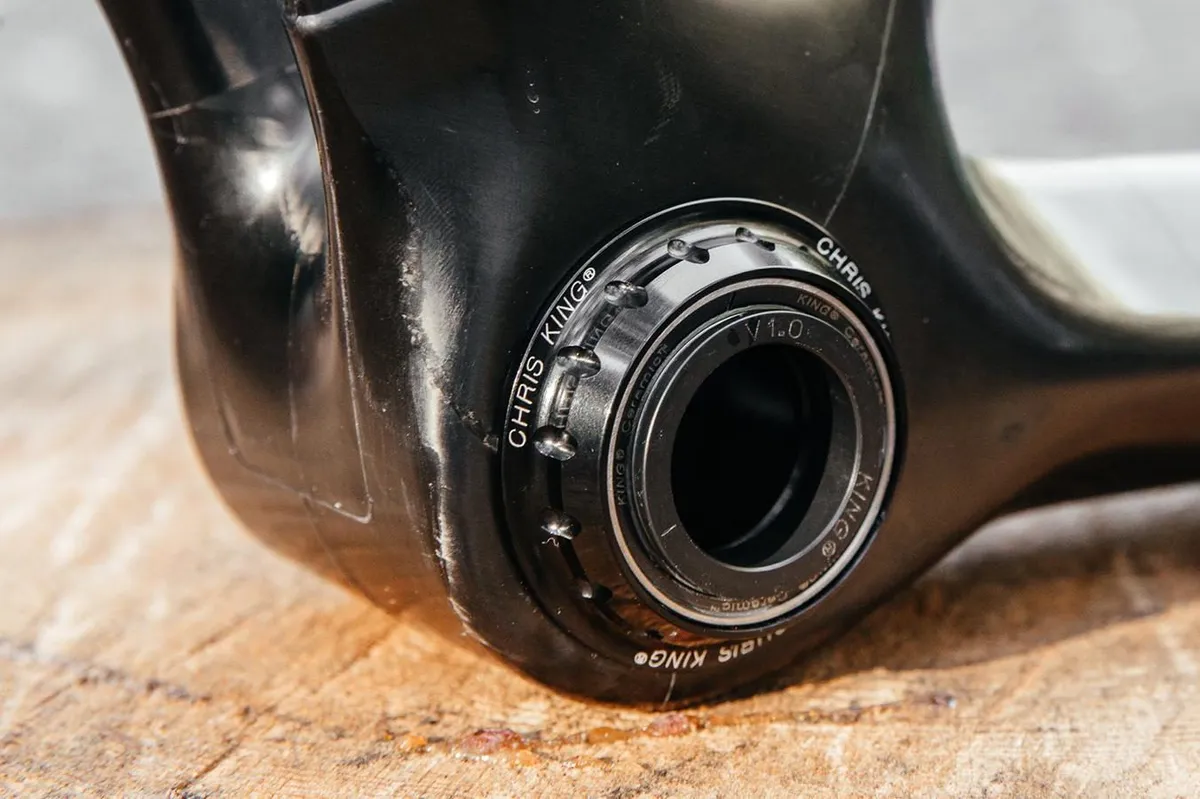
The design comes about as a solution to the well documented creaking issues associated with oversized press-fit systems. While these issues are near always the result of poor tolerances, the T47 standard promises to fix the creaking issue without sacrificing the benefits of an oversized interface.
As it stands, this new standard may just become the hot new thing among smaller manufacturers of metal bikes.
The need for a heavier metal interface looked like a limiting factor for mass-produced carbon bikes, but with a manufacturer like Trek on now on board (as mentioned above, its 2020 Domane features a T47 BB) that could all be about to change.
- Pros: Vast crankset compatibility, open standard, threaded design easy to service and prevent from creaking, same dimensions as PF30
- Cons: New tooling needed for manufacture, requires metal threads, weight
- Crank designs that will fit: All (dependent on axle width)
Colnago ThreadFit 82.5 bottom brackets
Threadfit 82.5 is not really a new standard in that it is compatible with BB86 cranksets and bearings.
Rather than press the BB86 bottom bracket directly into the frame, the ThreadFit system threads an aluminium shell into the frame first, which provides the interface for the bearings to sit in.
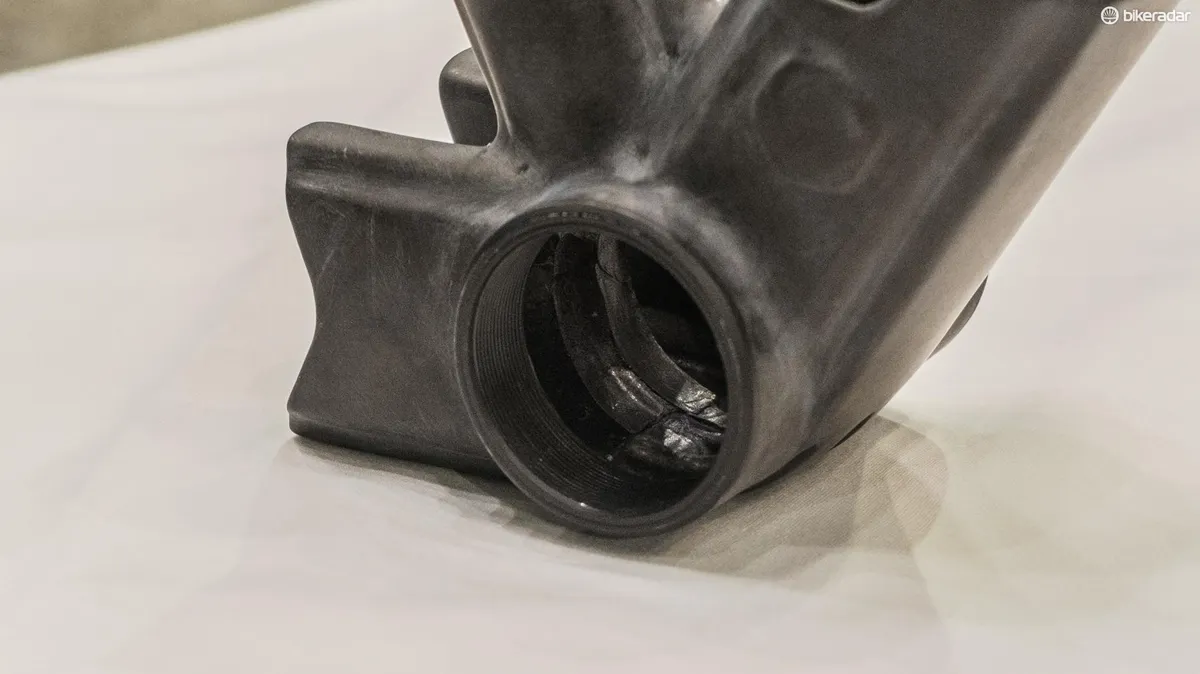
According to Colnago, this allows dimensions and tolerances to be controlled more accurately. Additionally, it allows the bottom bracket interface to be replaced easily if it wears over time or after multiple bottom bracket replacements.
With the release of the C64 bike, Colnago, in collaboration with CeramicSpeed, designed a ThreadFit 82.5 bottom bracket that fits the bearings directly into the shell that threads into the frame — effectively a proprietary T47 design. This also allows a larger 30mm spindle crank to be installed.
- Pros: As for PF86
- Cons: As for PF86
- Crank designs that will fit: Standard 24mm external-type, Shimano, SRAM GXP, Campagnolo and 30mm spindle cranks for CeramicSpeed bottom bracket
SRAM DUB bottom brackets (Durable, Unifying Bottom Bracket)
DUB (Durable, Unifying Bottom bracket) may sound like a new standard, but really it’s a new axle diameter specification for mountain bike cranks (in 2019, SRAM also started rolling out DUB cranksets in the road line-up).
SRAM claims that the focus on optimising the bearings resulted in a spindle diameter of 28.99mm. This places is right between SRAM's old 24mm GXP cranks and 30mm spindles of modern cranks.
Thankfully DUB has been designed with major bottom bracket standards in mind, allowing the cranks to be fitted to the most common designs with the choice of the appropriate bottom bracket.
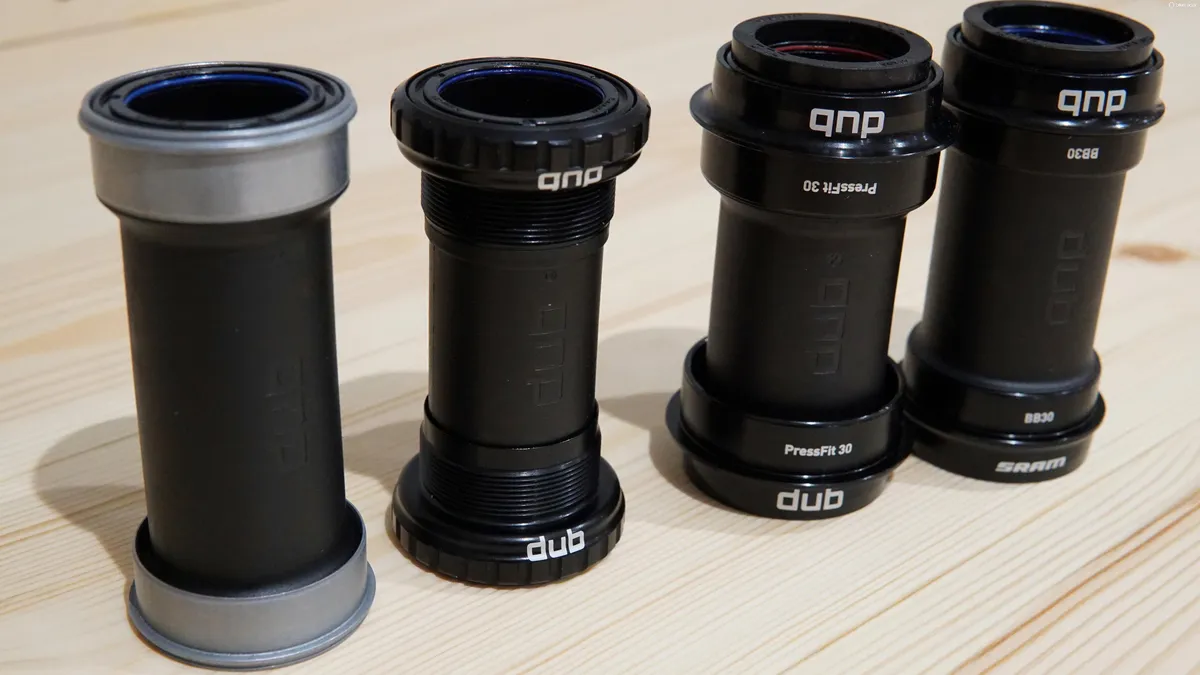
DUB is compatible with BSA threaded, PF86, PF92, BB30 (73mm shell) and PF30 (73mm shell) bottom brackets and cranksets are completely interchangeable between the different standards.
This is achieved by placing the bearings at the same axial location along the bottom bracket axis — in the case of BB30 and PF30 bottom brackets, that results in the bearings being located outboard of the frame.
- Pros: Claims of improved sealing and durability, compatible with major BB standards, cross-compatibility for DUB cranksets
- Cons: Proprietary system
- Crank designs that will fit: DUB
Will my cranks fit my bike?
While cranks designed specifically for your bottom bracket will fit, at some point you may want or need to adapt ‘non-standard’ cranks to your bottom bracket. It’s hard to confirm compatibility without looking at the specific combination of crankset and bottom bracket, but there are some rules of thumb we can apply.
Generally, your replacement cranks may have the same or smaller spindle diameter, and the same or longer spindle length than the system your bottom bracket is designed around.
For example, a BB30/PF30 bottom bracket has the narrowest shell width of any of the standards, whilst being designed for large 30mm spindles. That means it should be able to take most cranks with appropriate adapters and spacers to take up the ‘space’ of a narrower and/or longer spindle.
However, it’s worth bearing in mind that using a stack of spacers may not be the optimum solution for performance (read stiffness) and reliability.
On the other hand, a BB30 crankset, being specifically designed for a BB30 bottom bracket is generally not adaptable to many other systems, due to the short spindle length matching the narrow shell width. Newer BB30 cranks have started using longer spindles to make them a bit more versatile.
At the other end of the spectrum, Trek’s proprietary BB90/BB95 bottom bracket is designed around a wide shell and narrow spindle, meaning it is limited to traditional 24mm spindle cranks.
Various other bottom bracket standards lie between these two extremes. Take these guidelines with a pinch of salt and always be sure to double check what you can fit before committing to a new crankset.
How do I change to a different crankset?
As you've likely noticed in the footnotes above, most of the bottom bracket standards offer a fairly wide range of options in terms of crankset choice. And, not surprisingly, several companies are at the ready to help you make those changes.
Current players in the mix-and-match field include Wheels Manufacturing, Rotor, Praxis Works, Enduro Bearings and even house brands of third-party distributors such as Quality Bicycle Parts' Problem Solvers.
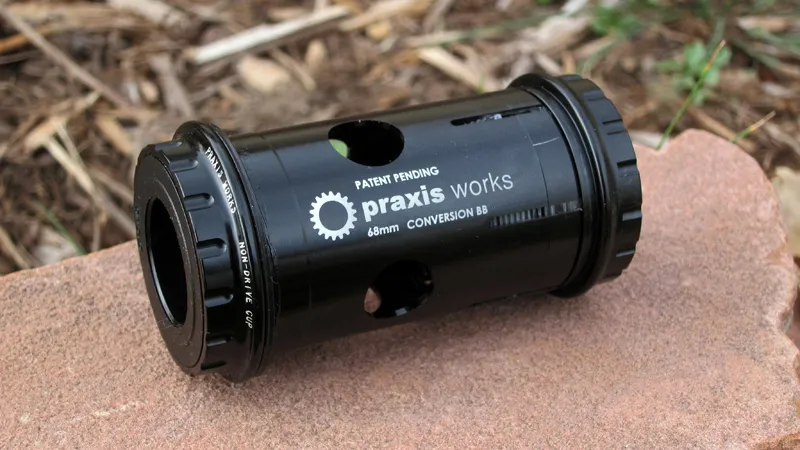
Changing between setups typically requires some type of adapter. Or, in ideal cases, bottom bracket bearing assemblies that directly convert from one system to another, such as Praxis Works' BB/PF30-to-24mm assembly.
In general, though, the guideline is the same: try to minimise the number of parts involved. More parts added on top of each other results in greater tolerance stack-ups, plus more interfaces that could potentially creak.
Why are there so many bottom bracket standards?
There's nothing wrong with threaded bottom brackets, per se, and it's worth noting that none of the proponents of alternative systems cast threaded systems as being fatally flawed. They do, however, note the system's inherent limitations in terms of frame design, which is why more companies — particularly ones striving to be on the cutting edge — continue to embrace non-threaded formats.
How companies decide to go about that — and precisely what design features they want — is the real issue, because everyone seems to have their own ideas on how to achieve the same goals (less weight, more stiffness, and lower manufacturing costs).
"The explosion of bottom bracket standards reflects the various design objectives and manufacturing competencies of individual frame and component brands," says Eric Doyne, US PR representative for Shimano. "Shimano sees and values the importance for consumers to be able to easily source a frequent consumption article like the bottom bracket.
"The explosion of standards is not good for consumers or dealers," Doyne continues. "The bottom line is that bike companies are driving the standards. Threaded systems have very few limitations — they are easily cleaned and repaired at the shop level, and they do not affect the bearing fit."
In concept, at least, all of the standards we've covered are functionally sound. But the realities of relaxing tolerances can create other issues.
For example, save for Shimano, Rotor, Specialized, and some FSA models that use adjustable effective crank arm-to-crank arm distance, most of these alternative systems require wave washers or compressible spacers to account for inherent shell width variability (Magic Motorcycle used precision micro-shims back in the day, and some third parties offer similar systems for modern cranksets).
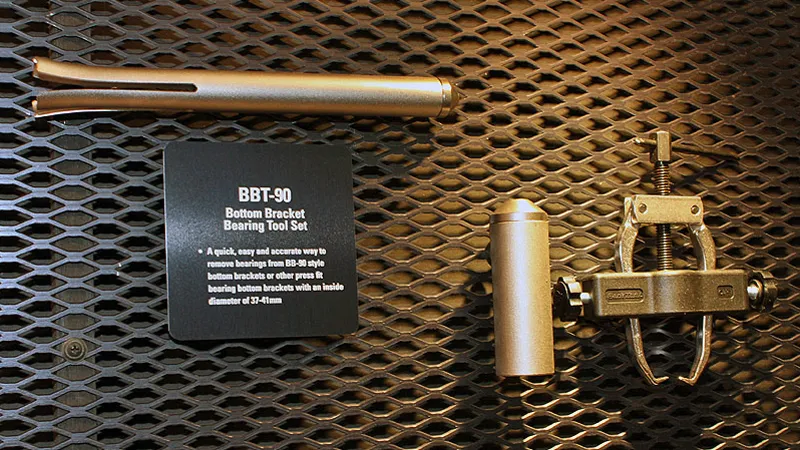
Things work okay if the installation is done correctly. But, if not, you could still end up with lateral play under load (possibly resulting in dropped chains) or bearings that are too heavily preloaded (decreasing bearing lifespan).
Weather-sealing can be a problem, too. Integrated cup and bearing systems at least have the potential for good barriers against dirt and moisture, depending on the design, but bottom bracket standards that rely solely on bearings pressed directly into the frame sometimes have to make do with the typically inadequate seals on the bearing cartridges themselves.
Some designs even offer discipline-specific advantages. For example, BB30 offers the narrowest potential Q-factor, while wider shells allow for greater chainstay spacing, for more tire clearance on mountain bike hardtails and cyclocross frames.
Finally, there are aesthetic considerations. Road companies often gravitate towards BB30 for the sleek, narrow form factor, while smaller builders dealing primarily in steel might prefer the more proportional look of a threaded shell. Carbon companies looking to maximise their stiffness (or stiffness-to-weight) figures generally just want to go bigger in some way.
As to which bottom bracket standard is 'best', the answer is undeniably straightforward: it depends.
This article was first published in March 2013 and was most recently updated in January 2020